A Tsavo Tale or Two...
 Sunday, September 26, 2010 at 12:48PM
Sunday, September 26, 2010 at 12:48PM 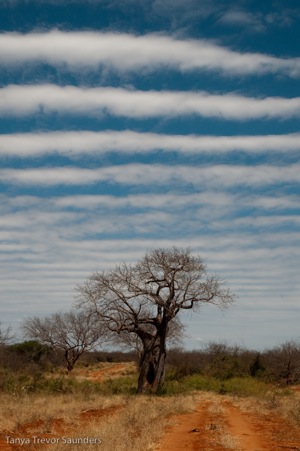 STRIPEY TSAVO SKY
STRIPEY TSAVO SKYWe have spent far too much time away from Kulafumbi this year and, combined with always finding myself far too busy for my own good (I’m sure!), the telling of this tale has suffered.
Ian and I spent the lion’s share of July and August “on the road” in America and Europe, promoting our work with the African Environmental Film Foundation. When we finally got home, we were met with a flood in our house from a leaking water pipe and – ironically – a broken water pump so we could not pump water from our well, which meant we had entirely too much water on our floor and not enough in our tanks! The joys of living in the bush…
But conversely, coming back to “our” gorgeous river and all our four-legged and feathered friends never fails to be magical. When I wake up early in the morning, and there is not even a whisper of human sound, just the birds and the river, I really feel like there is no other place on earth quite like Kulafumbi.
The dry season is in full swing now, which means there are lots of animals back on the river, as inland waterholes have mostly dried up. But the wind has been incredibly cold for this time of year, and the nights are colder than anything we’ve experienced since living here, requiring two blankets on our bed.
I’m going to have to backtrack somewhat, to catch up on a few snippets of interest that happened before we left for our intercontinental travels. Of course, as you will remember from my previous posts, we had finally had good rains and the Tsavo landscape was transformed into a green wonderland. Strangely the flowers did not blossom in their usual profusion, although the Ipomea Mombassana bucked the trend, flowering in huge quantities for a sustained period of time. Ian calls them "tissue paper flowers", and you can see why:
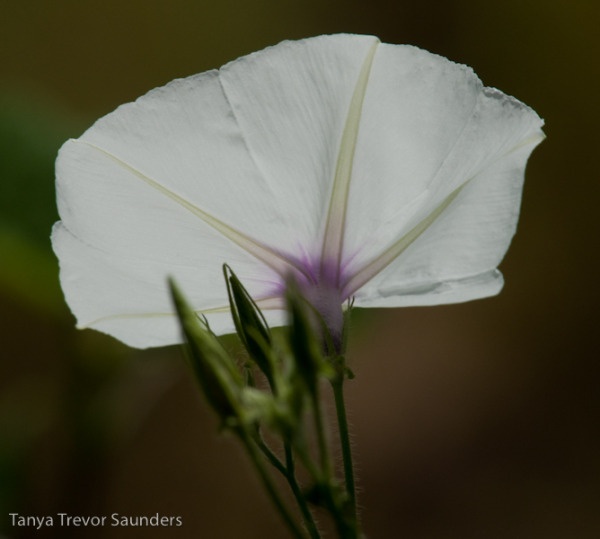
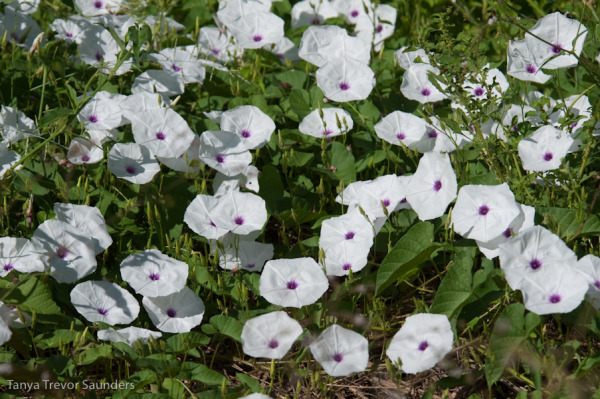
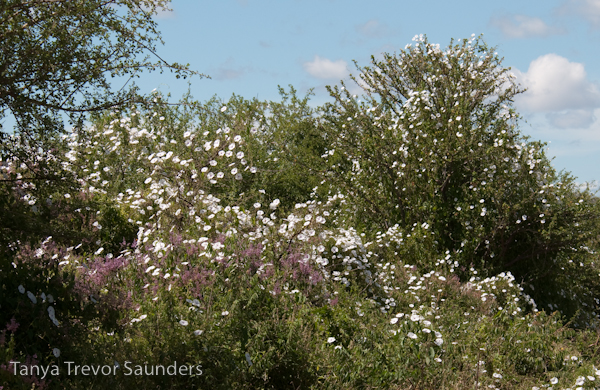
Ian and I spent some very happy Sundays driving out into this luscious green paradise.
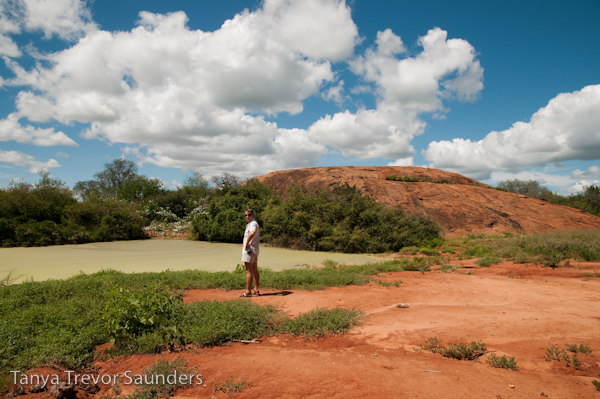
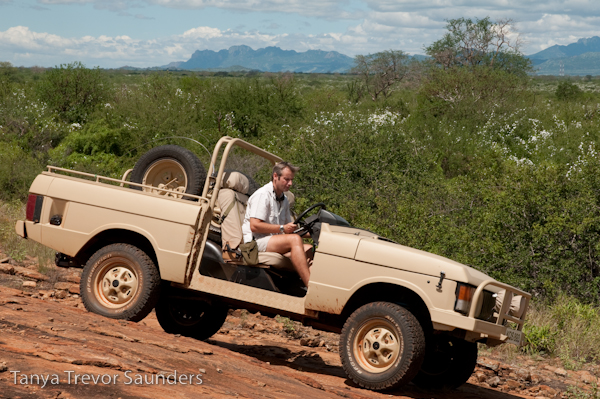
The butterflies seemed contented too, at least while the acacia were flowering:
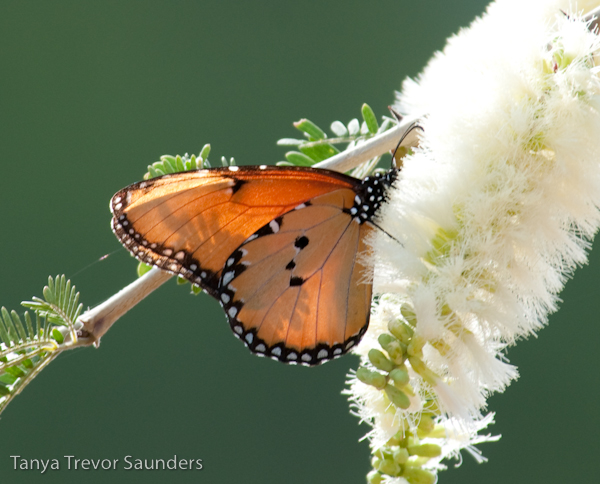
Our Egyptian Geese pair brought three tiny new goslings to the river in June, but sadly, none of them made it…it’s a tough life when you’re that tiny in a place full of hungry predators.
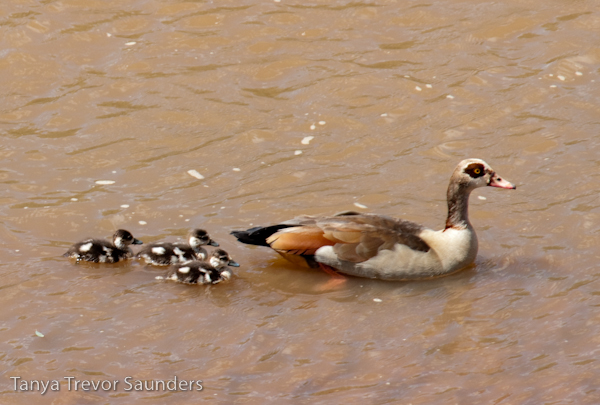
The Spur-winged Plovers continued (and continue to this day) to insist on choosing high-risk nesting options. In their wisdom, they have decided to nest on a tiny island in the middle of the river. They’ve been pursuing this folly for months and months, but it seems that they still haven’t worked out that their chicks are not goslings and cannot swim…and exposed on that island, they would have no chance of survival, even if the eggs hatched:
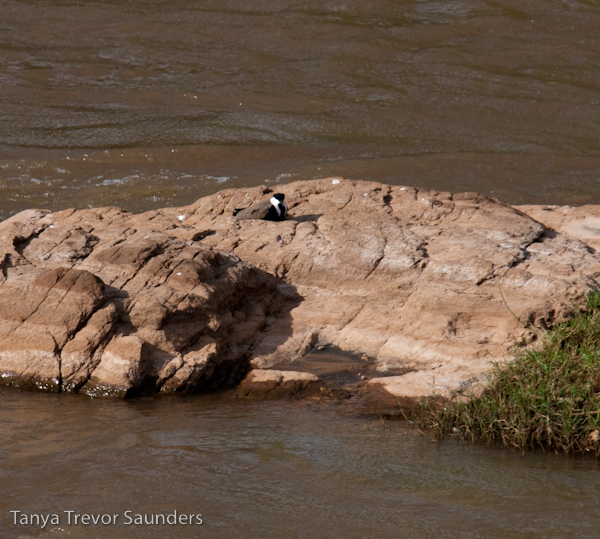
Terror arrived on our lawn in the shape of a Python – terror, that is, for the starlings, hyraxes and baby monkeys who did not quite know what to make of it and kept a safe but inquisitive distance. Not terror for us, of course, as we know the Python is not a risk or threat at all to us. He’s very welcome on our lawn, if that’s where he wants to be…although I don’t envisage the starlings giving him a moment’s rest whenever he does come out in the open:
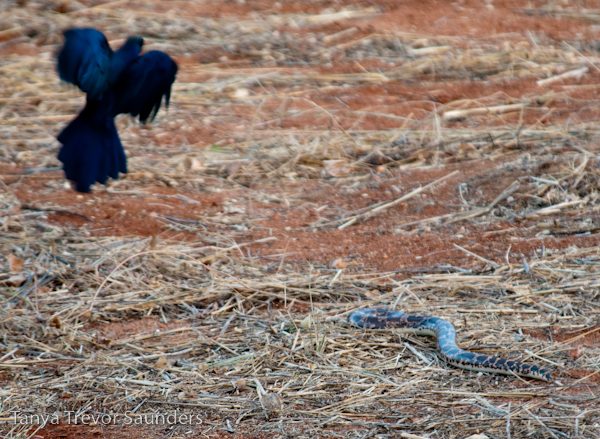
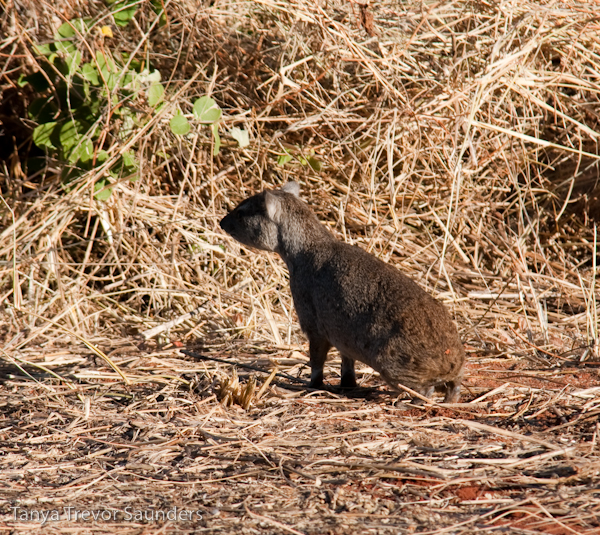
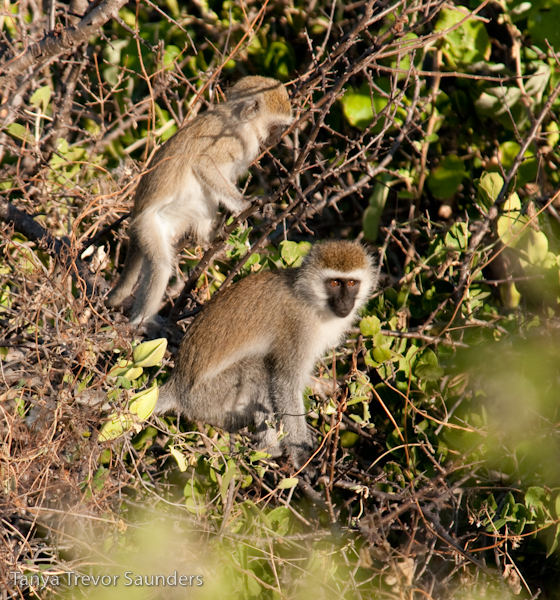
Another, less contentious, visitor to our lawn was an African Hoopoe on the 13th July. They are rather impressive-looking birds with their long curved beaks and striking colours (shame about the light that day, making the photo rather dull).
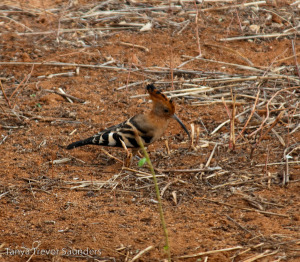
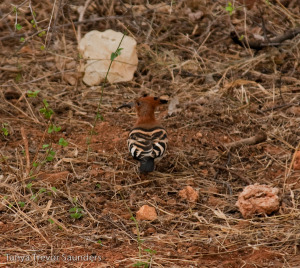
The Hyraxes continue in their voracious fashion, devouring anything green in their path and driving Ian to distraction because they are constantly trying to invade the house where they leave their rather copious calling-cards everywhere…and they’ve eaten many of my beautiful aloes so they’re not exactly in my good books either…although I still think they are comical and forgive them their sins because of that! They will go to any acrobatic length to reach a juicy morsel, even if it means devouring our lovely melia tree (one of our wedding presents, which has grown to a fair height in three years, despite the Hyraxes’ best efforts). They will tight-rope-walk right to the end of even the most spindly branches, hanging on as the branch bends almost to breaking point and then, balanced upside down, they nibble gingerly at the green shoots on the end of the branch, until eventually, they lose balance, the branch springs back up like a whip and the Hyraxes fall to the ground. Then it’s back up the tree, and start all over again…
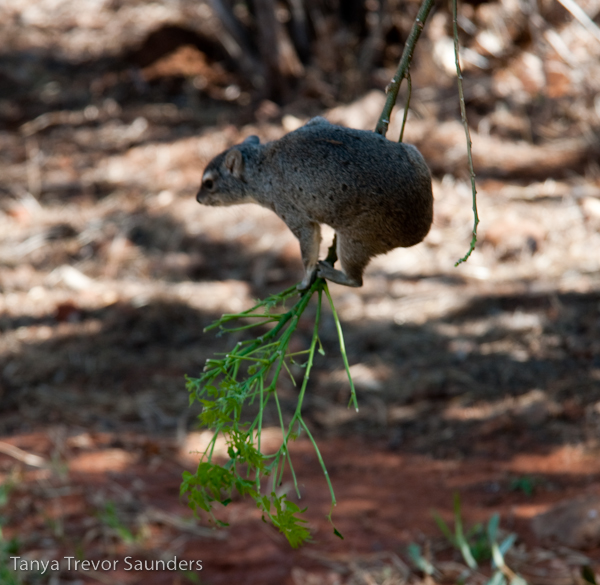
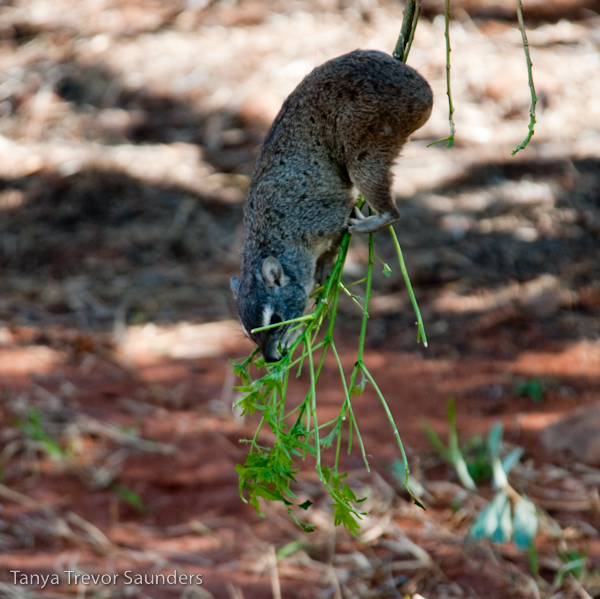
Crocodiles are cannibals. Back in July, we noticed that a couple of crocodiles were eating something and, on taking a closer look, we realized it was another crocodile. We had no way of knowing whether they had actually killed it or they were merely scavenging – but they were certainly eating one of their own kind. In the photos, the white thing is the dead crocodile.
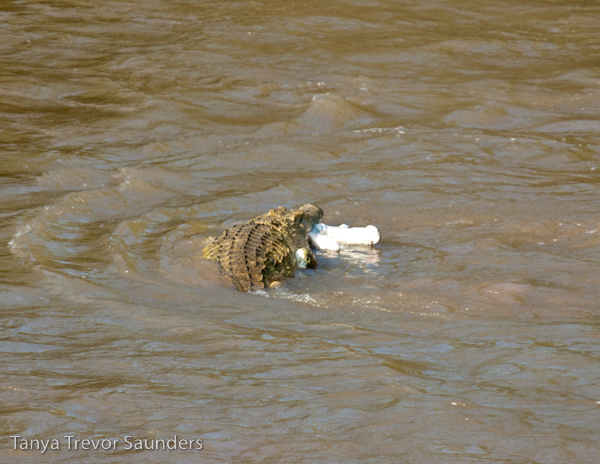
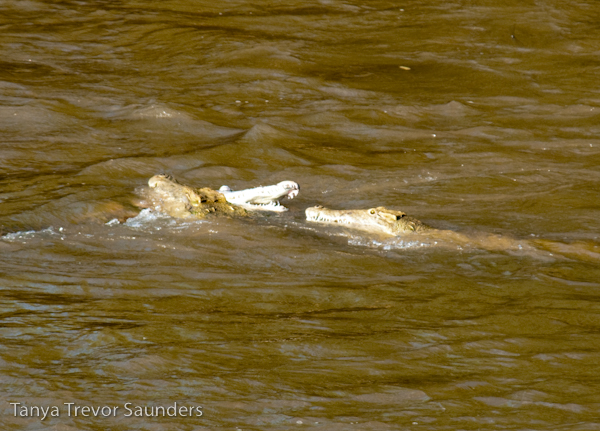
And on a happier note, in June a new young Genet turned up at dinner time – about half the size of the adults, and extremely tame. It must be a baby of one of our resident Genets, and has grown up knowing we are harmless (and an easy source of food). We named it Nosy Big-Foot because of its inquisitive nature and its abnormally large paws for such a small beast.
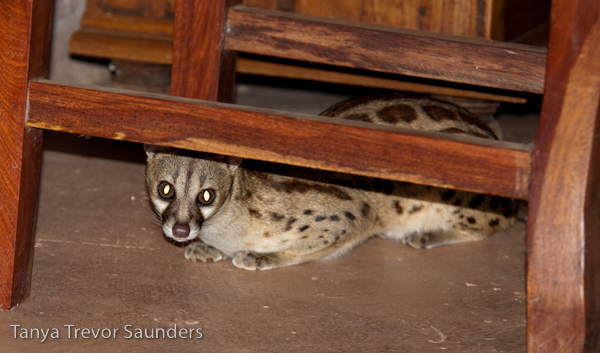 NOSY BIG-FOOT ON 30 JUNE 2010
NOSY BIG-FOOT ON 30 JUNE 2010
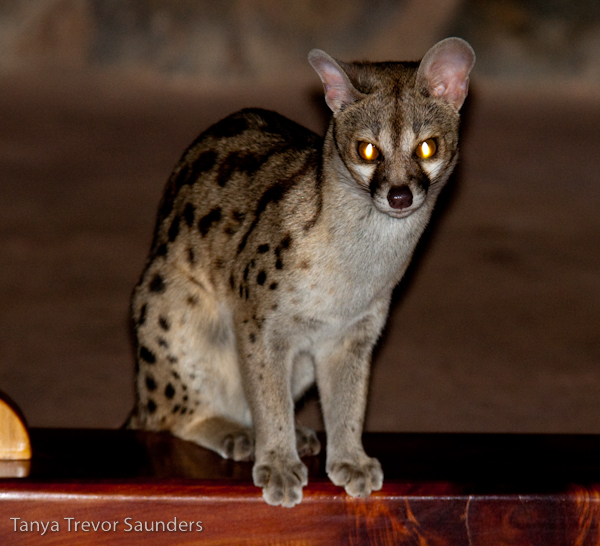 NOSY BIG-FOOT...BIGGER BY SEPTEMBER
NOSY BIG-FOOT...BIGGER BY SEPTEMBER
When we returned from our overseas travels, all our Genets were right there at dinner time, as if we had never been away. Nosy Big-Foot has grown substantially larger by now. Jean-Genie is still around and Two-Notch Charlie, not to be outdone, also still comes to take food from our hand (and off our plates, if we're not watching!)…
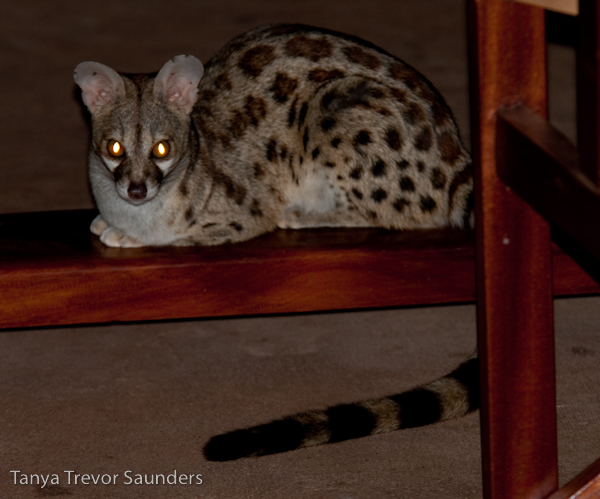 TWO-NOTCH CHARLIE
TWO-NOTCH CHARLIE
And then, a couple of weeks ago, another baby appeared – even smaller than Nosy Big-Foot was when we first saw him. We haven’t named it yet, but it is the sweetest thing you ever saw, and is also fairly tame. It’s lovely to see “our” Genets breeding and bringing their offspring with them into the house – one tends to forget that they are wild animals, but that is the fact which makes this so incredibly special.
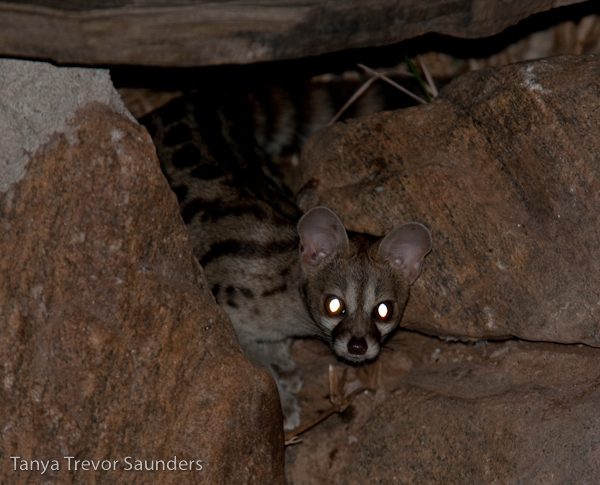
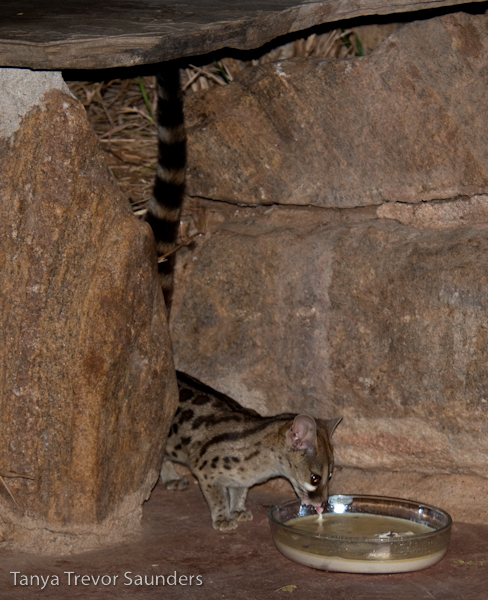 NEW BABY GENET (both photos above)
NEW BABY GENET (both photos above)
Now that the dry season has set in, the Dik Diks are back for their daily portion of maize. They have a baby in tow too – though it’s quite big by now.
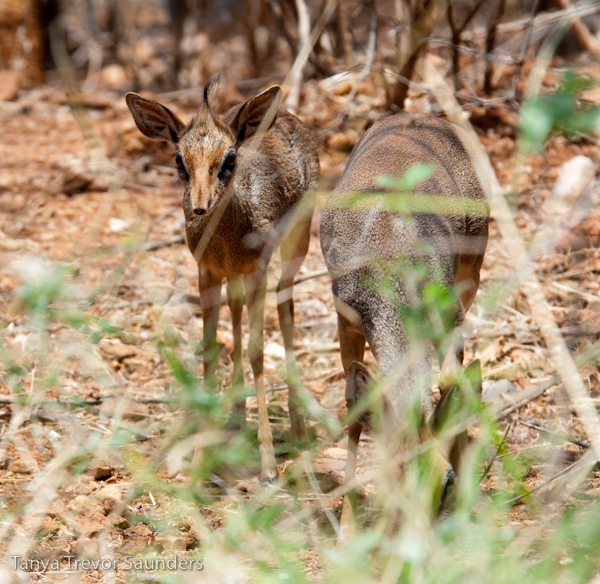 THE BABY DIK DIK (ABOVE, ON THE LEFT) IS SIGNIFICANTLY SMALLER THAN THE ADULT.
THE BABY DIK DIK (ABOVE, ON THE LEFT) IS SIGNIFICANTLY SMALLER THAN THE ADULT.
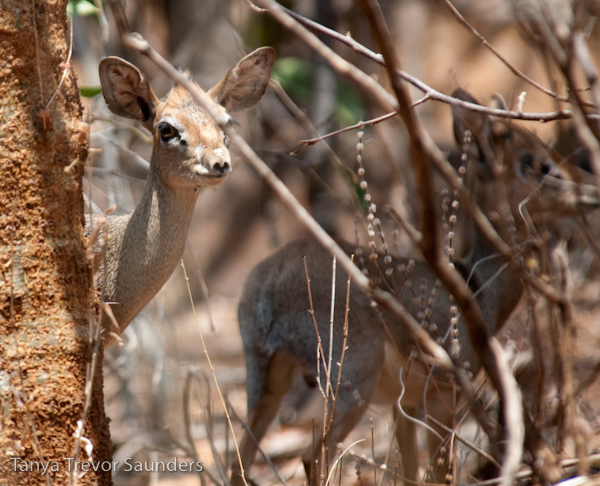 SO WELL HIDDEN...
SO WELL HIDDEN...
Dik Diks are fabulously well camouflaged in the dry bush, which they need to be with all the predators that target these tiny antelope, not least the might Martial Eagle which is back hunting along this stretch of river again.
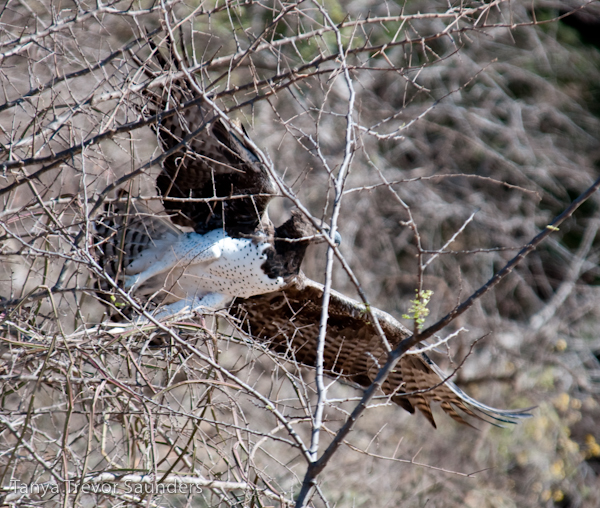
Along with the ever-present Vervet Monkeys and the Ground Squirrels, a whole host of birds are coming join the daily feeding frenzy outside the kitchen: doves, sparrows, starlings, hornbills, buffalo weavers, francolins…you name it.
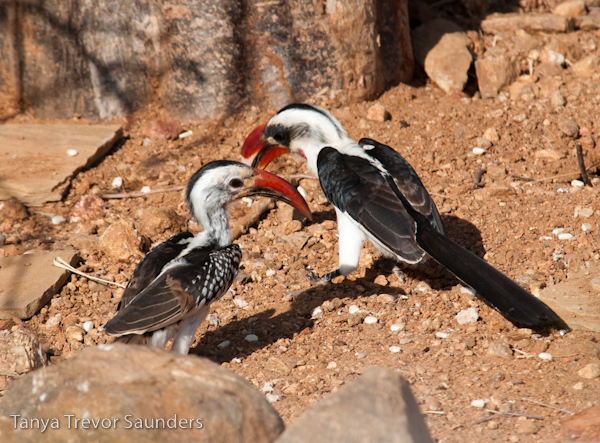 RED-BILLED HORNBILL (FRONT) AND VON DER DECKEN HORNBILL
RED-BILLED HORNBILL (FRONT) AND VON DER DECKEN HORNBILL
And during breakfast and lunch, which we eat on our balcony, we also have several more beaks to feed by the table, mainly the Glossy Starlings, Superb Starlings and Bulbuls. Then there’s Hook, the Ground Squirrel, who thinks he owns the place…but he’s no trouble, so that’s OK.
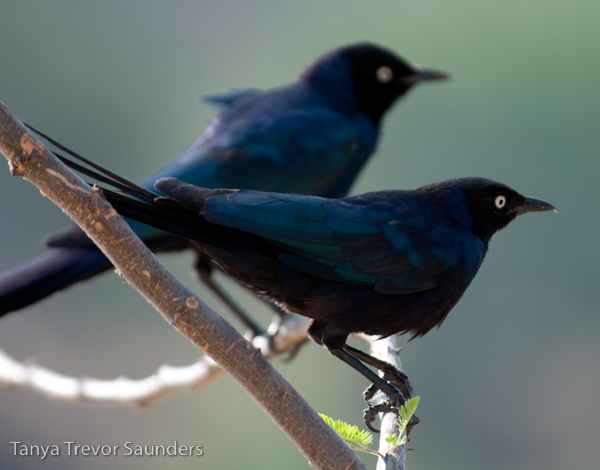 "THE TERRIBLE TWO"...THIS GLOSSY STARLING PAIR NOTICE IMMEDIATELY WE ARE ON THE BALCONY AND COME FOR FOOD
"THE TERRIBLE TWO"...THIS GLOSSY STARLING PAIR NOTICE IMMEDIATELY WE ARE ON THE BALCONY AND COME FOR FOOD
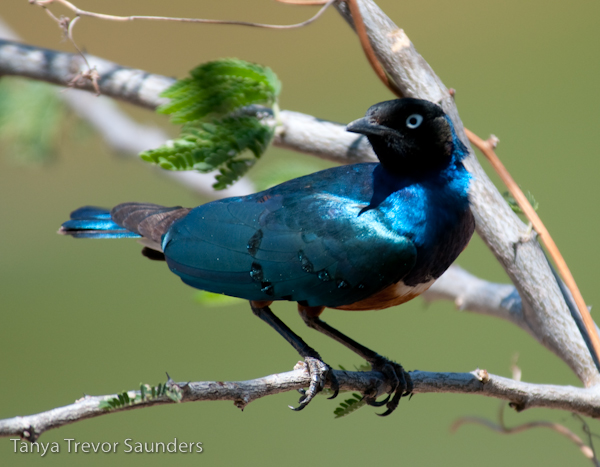 SUPERB STARLING (ABOVE) AND YOUNGSTER (BELOW)...ALSO AVID BEGGARS!
SUPERB STARLING (ABOVE) AND YOUNGSTER (BELOW)...ALSO AVID BEGGARS!
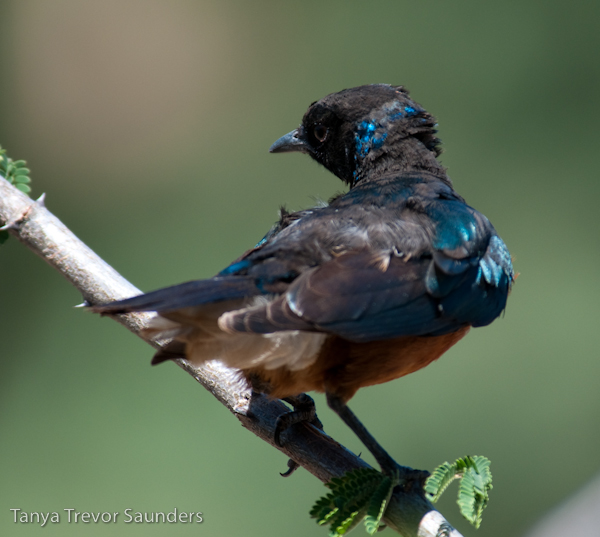
I'm not the only one under pressure to feed a horde of hungry mouths. A pair of Wire-tailed Swallows have been nesting on our balcony, and they certainly had their work cut out for them raising their hungry brood. The chicks all flew the nest before we went overseas but - amazingly - they return to it at night, along with the parents...so five birds all squeeze into it at night!
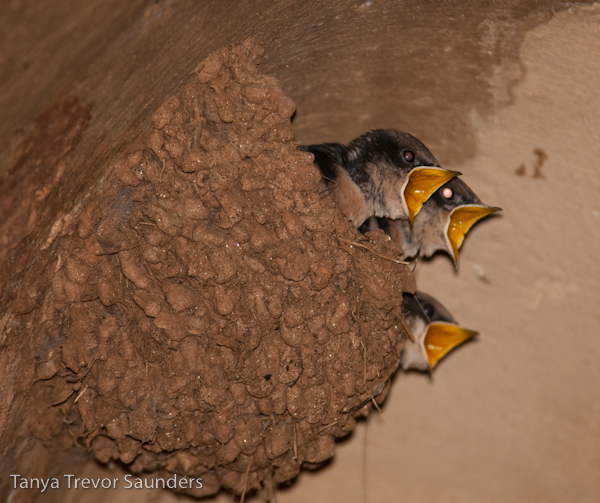
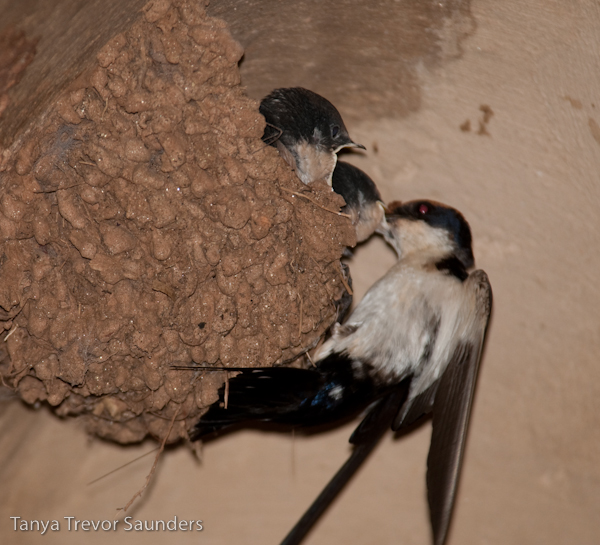
Slim, the Black-tipped Mongoose, is still very much around, always on the lookout for a free morsel too, turning up on the lawn and staring pitifully up at the kitchen if that’s where I happen to be at the time. If not, in he comes and looks for his own scraps on the balcony, or even right into the kitchen at times.
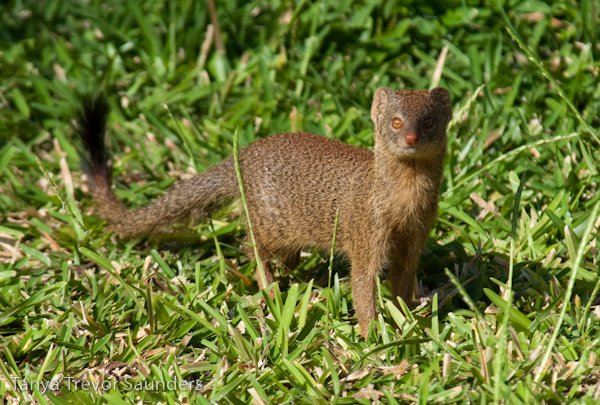 THE NOTORIOUS 'SLIM'
THE NOTORIOUS 'SLIM'
The sandbanks along the river’s edge are turning green with new shoots, and the antelope are taking full advantage – daily we see Impala, Waterbuck, Kudu and Dik Diks making the most of it. In the early mornings, they run and leap and indulge in high spirits – a joy to watch, for it means they are feeling safe and healthy, and what more could one wish for?
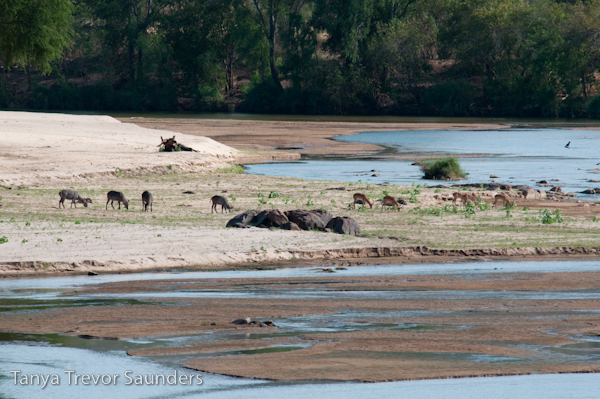
Do you remember One Horn, the young Impala buck, whose one horn had snapped off? We've been watching him grow up - look how big and strong he is now! [Click here to see him back in July 2008]. His broken horn has also started growing again, although it looks like it will never have its sharp tip:
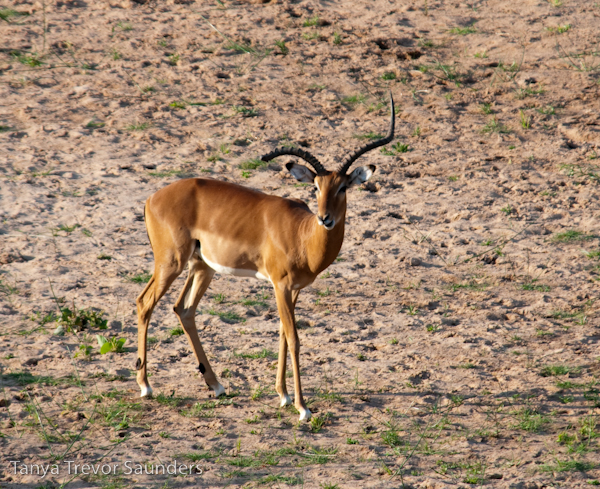
Some of the waders are back too, alongside the resident Three Banded Plovers:
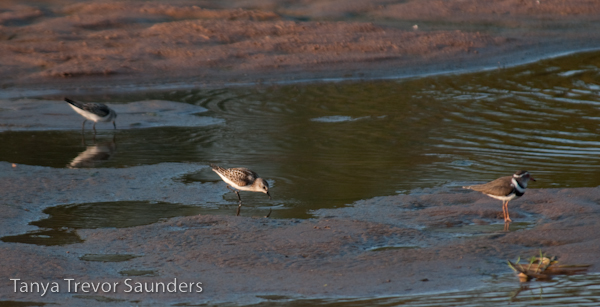
A rather lovely Lilac Breasted Roller is using a perch just by the house, flashing iridescent blue as it swoops into the air for an insect.
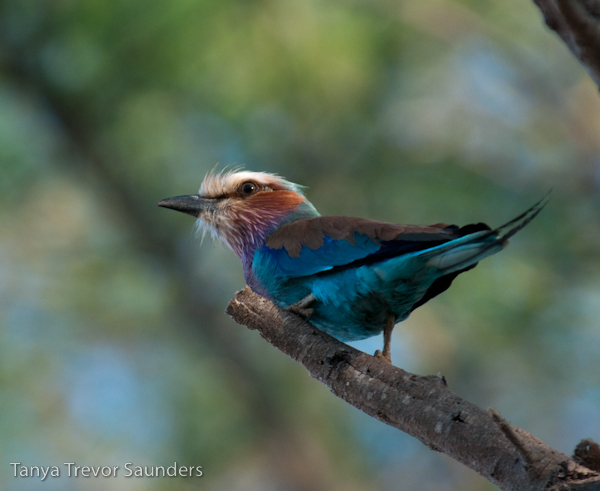
We’ve got at least 25 hippos in the river at Hippo Bend, more than we had last year, which is wonderful. We’ve also got lots of bees in our beehives, so are looking forward to a good crop of honey this year (if the Honey Badgers don’t get there first!). And the Quelea have arrived en masse on the river too. Although there were a few here in July (very unusual), these huge flocks of tiny seed eaters are now very much in the area, accompanied by opportunistic, fast-flying falcons. Sadly, we have not had the best of light for photography recently (which is unusual for September which is normally one the best months for the light in this part of the world), so my photos are not nearly as dramatic as they might have been. In fine light, as the huge Quelea flocks swoop down to drink, banking like golden confetti in the sun, they are magnificent to behold.
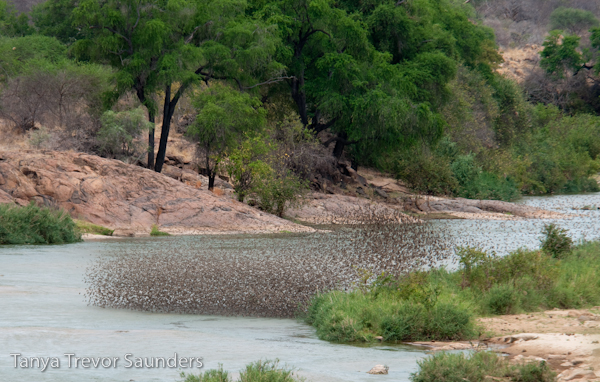
The other day, a small elephant turned up on the river all by itself. It must have been just two years old - so not tiny, but certainly much too young to be on its own. There have been a lot of elephants in the area, but to see this little one on its own was just not right. As it was too late in the evening to do anything immediately, Ian and the guys set out at daybreak to look for it but there was no sign of it. They did, however, come across a herd with a lot of youngsters in it, just nearby, so we are hoping that all ended well, and the little one was reunited with its herd.
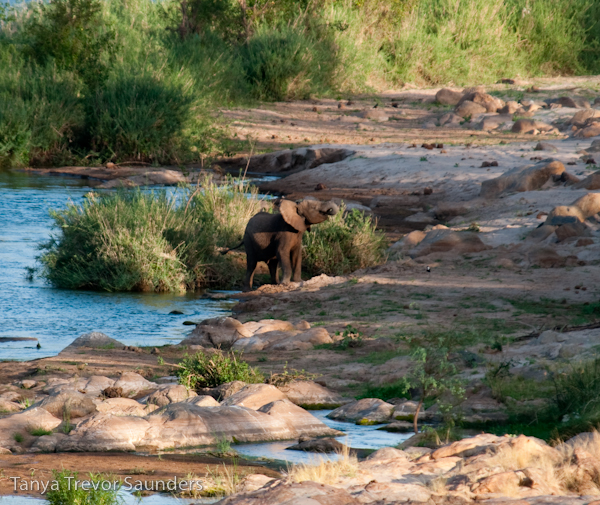
Perhaps I should have called this 'A Tsavo Tail or Two'...Look at this gecko with a forked tail. It looks like he lost some of his tail, and then it has started to re-grow, but somehow from half way down his original tail. Anyway, he lives in our kitchen:
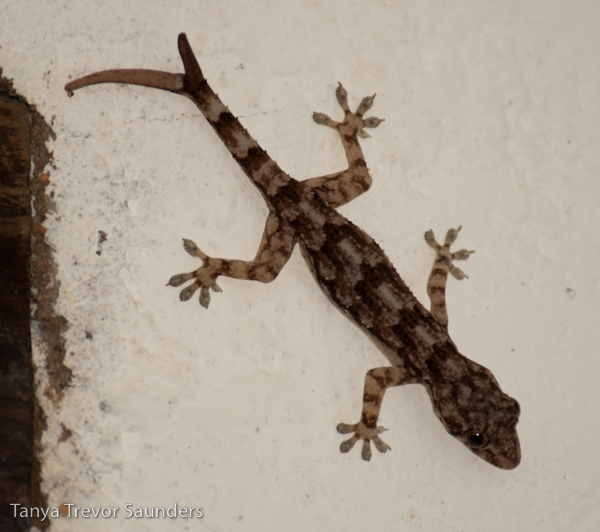
And finally, to round up the round up, we have a new alarm clock - in the form of a pair of Von Der Decken Hornbills who turn up every morning outside our bedroom window at 6.30am. These birds are somewhat narcissistic and love to stare at their own reflection in the glass – perhaps believing there is a rather beautiful rival staring right back at them. But in order to partake of this pleasure, they have to fly headlong at the window, then reach out with their feet and grab the wooden crossbar. Inevitably, because their beaks are so long, their beaks hit first with an almighty crash – hence the wake-up call. Then tail splayed against the window, claws holding on for all they’re worth, they can gaze for a few moments at their own reflection.
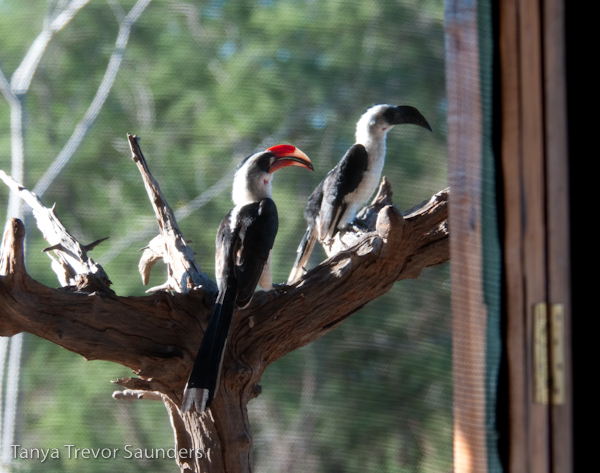 SITTING IN WAIT...MR AND MRS...
SITTING IN WAIT...MR AND MRS...
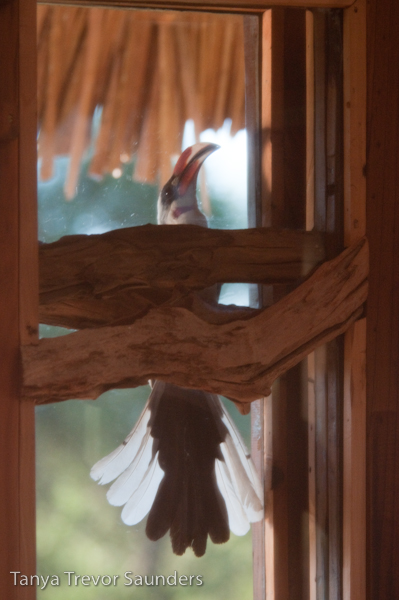 ...AND SPLAT AGAINST THE WINDOW
...AND SPLAT AGAINST THE WINDOW
As if the early morning bedroom performance is not enough, they have now taken to following us around the house, and if we’re in the living room or downstairs in the office, that’s where they’ll be too, endlessly head-banging on the windows…what a crazy place we live in!
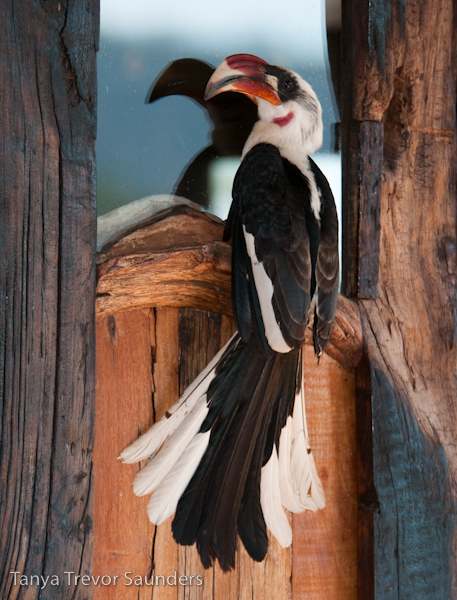
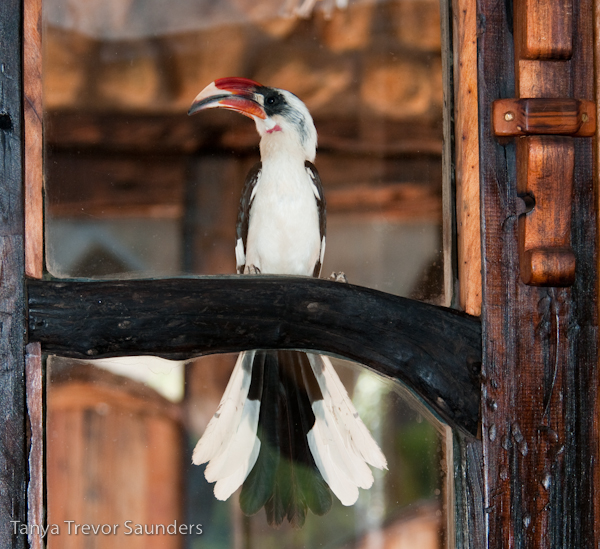 FROM THE INSIDE LOOKING OUT....
FROM THE INSIDE LOOKING OUT....
 7 Comments |
7 Comments |  Tanya | in
Tanya | in  "Our" Egyptian Goose Family,
"Our" Egyptian Goose Family,  Animals In House,
Animals In House,  Animals with Babies,
Animals with Babies,  Antelope (general),
Antelope (general),  Big Game (general),
Big Game (general),  Birdbath & Bird Table,
Birdbath & Bird Table,  Birds (eagles),
Birds (eagles),  Birds (general),
Birds (general),  Birds (migrants),
Birds (migrants),  Birds (nesting),
Birds (nesting),  Crocodiles,
Crocodiles,  Dik Diks,
Dik Diks,  Elephants,
Elephants,  Flowers,
Flowers,  Genet Cat,
Genet Cat,  Hippo,
Hippo,  Hippo Lawn,
Hippo Lawn,  Impala,
Impala,  Kudu,
Kudu,  Mongooses,
Mongooses,  Monkeys & Baboons,
Monkeys & Baboons,  Plants (general),
Plants (general),  River Level Medium,
River Level Medium,  Slim, the Black-Tipped Mongoose,
Slim, the Black-Tipped Mongoose,  Small Animals (general),
Small Animals (general),  Snakes,
Snakes,  Squirrels,
Squirrels,  Waterbuck
Waterbuck 




Reader Comments (7)
Hi Tanya - great to hear from you again (and some lovely photos!) As ever, has me yearning to be back in the African bush!
I have been following your blog and love reading it - I also enjoy your beautiful pictures. Glad you're back .
super article
Lovely to see you back! I so enjoy reading about Kulafumbi and seeing your wonderful photos.
The genets really capture my heart. There's something special about them.
Thanks to you all - it's great to back at Kulafumbi and back writing again!
Hi Imogen! Hi Denise!
Tanya hats off to your work...I was just looking for the blog on Kulafumbi and accidentally i found your blog...But after reading and seeing your clicked pics i fell in love with your blog...Every post in the blog delivers a different information and the well clicked photographs of wild creatures...This post also include fantastic and awesome pics..I liked the all...
villa lloret de mar
Tanya i love this post not because of the content but for the awesome pics you captured and posted here....The baby Dik-Dik and the pics of the birds are very well clicked...I like all the captures here....Thanks for making us a part of this lovely post...
vakantiehuizen ibiza